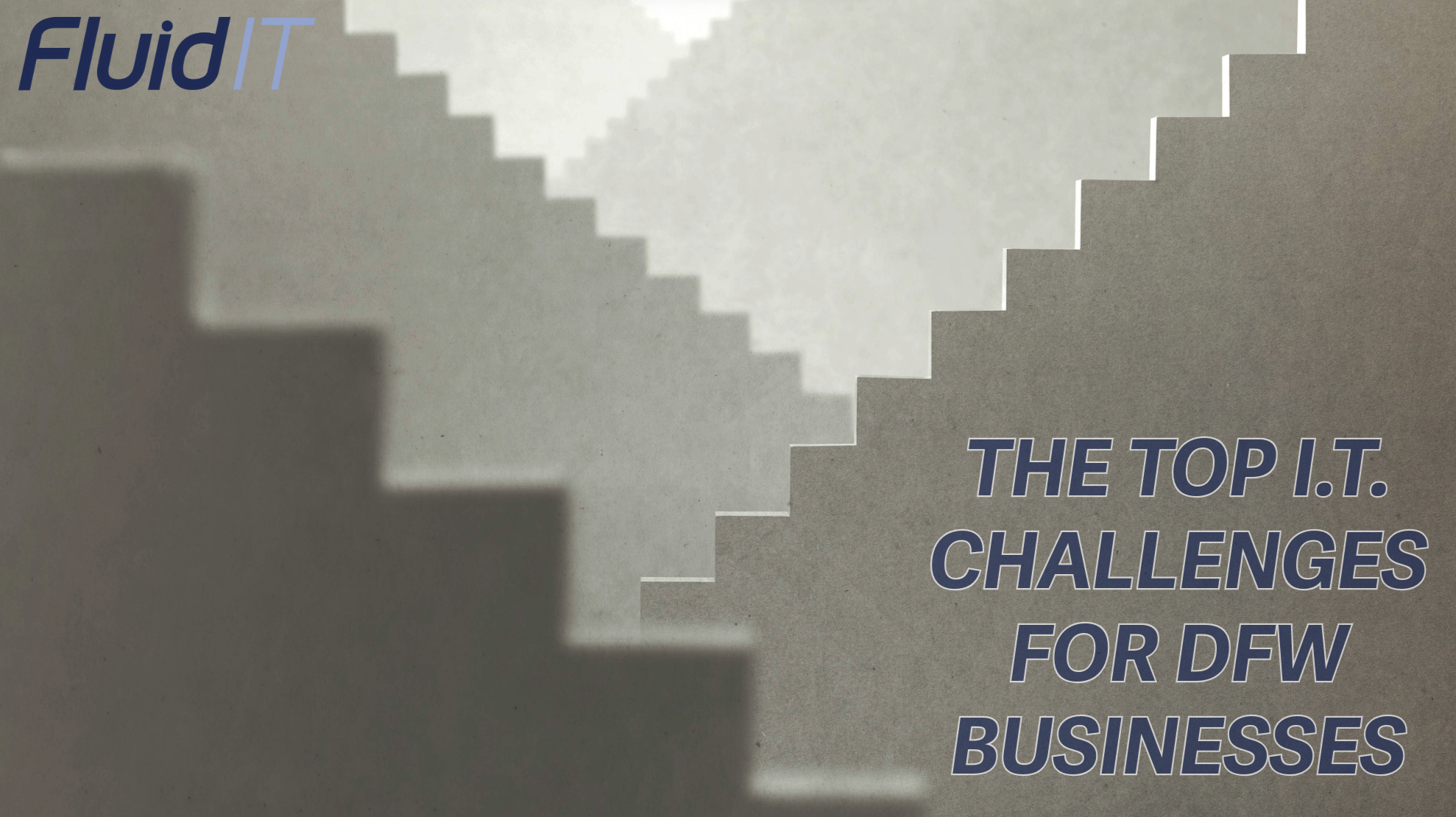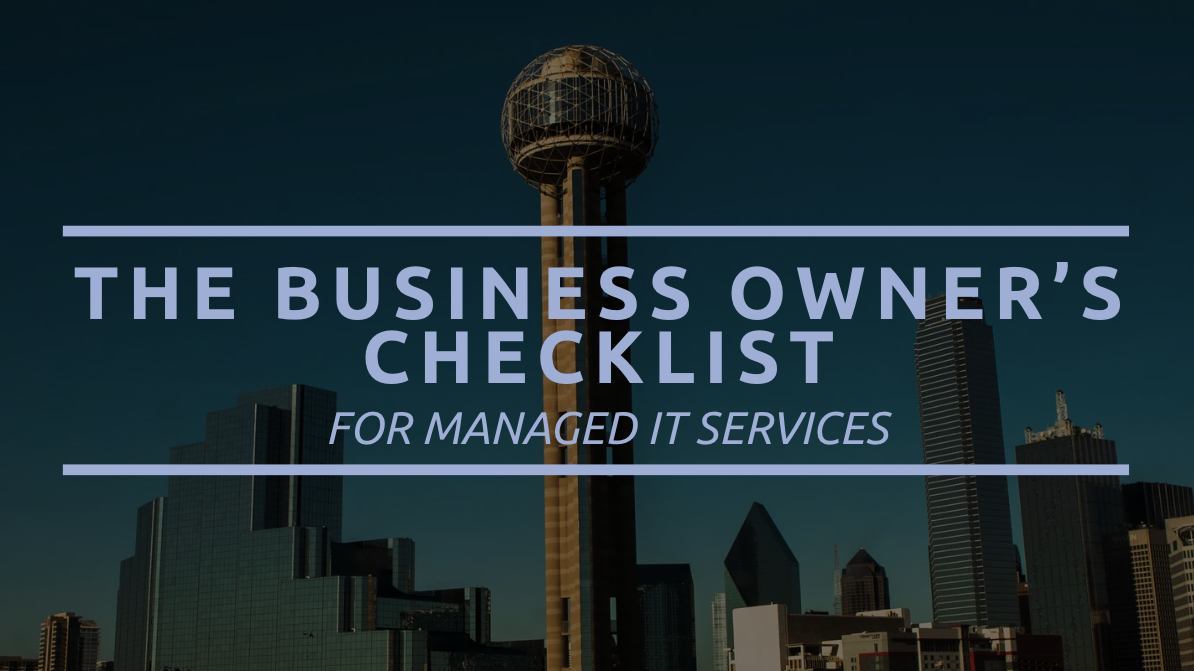Top 7 IT Challenges Faced by Growing DFW Businesses and How MSPs Solve Them
As businesses across Dallas and Fort Worth expand, their IT environments become more complex and harder to manage. From cybersecurity risks to...

As your business embarks on its journey of growth and expansion, you're undoubtedly familiar with the multifaceted challenges that come with entrepreneurship. In today's fast-paced digital landscape, effective IT management has become integral to your company's long-term success.
In this article, we'll explore four critical IT areas that remain as vital today as they were when you first ventured into the world of business. These insights will not only help your company thrive but also keep you ahead of the curve.
In the journey of growing your business, you're no stranger to wearing multiple hats. However, when it comes to IT management, it's common for this responsibility to fall on someone who isn't a tech expert. This often happens due to budget constraints or the pragmatic need to juggle various roles within your organization. Your financial controller or CFO, for example, may find themselves taking on this role because they're well-versed in managing costs.
It's important to acknowledge that this “IT point person” may not have an IT background or a deep understanding of technical intricacies. Still, they play a pivotal role in ensuring that critical IT elements align with your business goals. Their responsibilities include:
In the early stages of your company's growth, this IT point person is a valuable asset, helping you navigate IT challenges and maintain operational continuity. However, as your business expands and technology becomes increasingly integral, you'll inevitably reach a point where the complexities of IT demand specialized expertise.
At this juncture, IT partners, such as IT service providers, become crucial. These partners can help bridge the gap between your business's IT needs and the resources at your disposal. They bring specialized knowledge, experience, and resources to the table, enabling you to focus on what you do best – growing your company.
As your business continues to thrive, there will come a time when the scope of IT management surpasses what an internal point person or even IT partners can handle efficiently. This is where trusted IT service providers like Fluid IT come into play. By partnering with us, you can transition IT management entirely to experts who are dedicated to ensuring your IT infrastructure is not just functional but optimized to support your growth.
In essence, your journey to success involves a gradual evolution of your IT management, from an informal point person to strategic IT partnerships, and ultimately to a trusted IT service provider like Fluid IT. This progression ensures that your IT capabilities always align with your company's ever-expanding horizons.
One key pitfall we frequently see are businesses not involving IT early enough in critical decisions. Many IT processes have fixed timelines, and no amount of urgency can expedite them. This delay often results in missed business objectives that directly affect your company's performance.
Consider these real-life examples:
It's a Friday afternoon, and your office manager casually mentions a new employee starting the following Monday, requiring a complete setup. While it might seem like a simple task, onboarding a new employee involves a series of steps. This includes ordering necessary equipment, obtaining additional software licenses, and configuring email and other systems.
The lead time for ordering a new workstation alone typically spans 2 to 4 weeks. Providing IT with at least 30 days' notice ensures that the new employee will have the essential tools ready to hit the ground running.
Picture this scenario: It's Monday, February 8th, and you announce that your company is opening a new branch on March 1. The space is secured, furniture is scheduled for delivery, and preparations are in full swing. Ten new employees are set to join on March 1, all of whom will require access to your company's systems.
While you might anticipate the challenge of getting machines in on time, as highlighted in the first example, there's an even more significant hurdle – securing Internet service for the new office. This involves not only identifying available options but also the substantial lead time, typically 30 to 45 days, required to activate a business-class Internet solution.
With only three weeks' notice in this scenario, your company may find itself in a new office with no Internet for 1 to 2 weeks, posing significant productivity challenges.
The marketing department decides to hire a new vendor to provide a customer relationship management (CRM) solution, with the vendor also developing custom capabilities. However, a crucial misstep occurs – IT is not part of the decision-making process. The result? The company discovers unfortunate surprises post-implementation, including the new solution's incompatibility with existing software, subpar vendor support, outdated technology, and non-compliance with essential requirements.
No one wants to find themselves saying, "I wish I had known about this six months ago."
The moral of these stories is crystal clear – involve IT as early as possible in your decision-making processes. While their expertise is invaluable, it's equally vital to recognize when their involvement may not be necessary for a particular decision. This proactive approach ensures smoother operations, avoids costly setbacks, and keeps your company on the path to success.
In the realm of IT, a stark distinction exists between business-grade solutions and their consumer-grade counterparts. Many companies steer clear of business-grade options due to their higher price tags. However, what often escapes consideration are the hidden costs associated with downtime due to equipment failures, increased support expenses required to maintain and manage these consumer-grade devices, and the overall lack of essential features, functionality, and robust security measures.
When you add up these concealed expenses, they consistently outweigh the initial cost difference between business-grade and consumer-grade solutions.
A frequently encountered scenario involves businesses hastily acquiring critical equipment from consumer-focused retailers like Best Buy. This equipment may include:
While these items may appear to meet basic needs, they fall short of the robust capabilities demanded by businesses. They are designed with homeowners in mind, omitting the extra features necessary for seamless business operations.
The key takeaway here is to involve IT at the outset of your decision-making process. IT professionals can provide valuable insights and recommendations tailored to meet your specific business requirements, while also ensuring that the selected solutions meet the stringent quality standards necessary for optimal features, security, and support. This proactive approach not only enhances efficiency but also safeguards your company against the hidden costs that often lurk behind consumer-grade choices.
In the world of IT, it's not uncommon for companies to adopt a "buy it and forget it" approach when it comes to their critical equipment. However, this laissez-faire attitude can have dire consequences.
Almost every piece of technology a company acquires should ideally come with a manufacturer's warranty and support agreement. These support agreements typically range from 1 to 3 years in duration. However, what's often overlooked is the fact that support agreements should never be allowed to lapse.
Why, you ask? Well, it's not a matter of "if" but "when" technical issues arise. Imagine this scenario: your company has a critical firewall support contract in place. The renewal notice is sent to the office manager. After a year or two of usage, the office manager has no recollection of the device and ignores the email. Unbeknownst to them, the firewall support contract lapses.
Then, fate strikes, and the firewall experiences a breakdown. IT is summoned to rectify the issue, and they promptly reach out to the manufacturer for assistance. To their dismay, they receive the devastating news that no support is available for the unit due to the lapsed contract.
What should have been a mere 1- to 2-hour outage now spirals into a week-long ordeal. Everyone is left scrambling to renew the support contract, leading to a significant negative impact on your business.
While maintaining an inventory of all your IT assets, complete with their support renewal dates, may seem tedious, it's far from being an insurmountable task. In reality, it's a straightforward process that yields substantial dividends. By keeping support agreements up to date, you can sidestep painful and unnecessary outages, ensuring that your business operations remain uninterrupted and thriving.
In your pursuit of business success, IT plays a pivotal role, and understanding the path to effective IT management is essential. From appointing your IT point person to involving IT early in decisions, avoiding consumer-grade solutions, and keeping support agreements up to date, you've explored four crucial IT areas that can make or break your journey.
Remember, as your company grows, so will its IT needs. You'll transition from relying on an internal IT point person to forming strategic partnerships with IT experts who can guide your technology decisions. Ultimately, you may find that trusting a dedicated IT service provider like Fluid IT is the key to unlocking your company's full potential.
With Fluid IT by your side, you gain a reliable partner dedicated to optimizing your IT infrastructure, ensuring it aligns seamlessly with your growth ambitions. We not only help you avoid IT pitfalls but also empower you to navigate the ever-evolving IT landscape with confidence.
As you move forward on your IT success journey, remember that every decision you make today impacts your company's tomorrow. Seize the opportunity to partner with Fluid IT and secure your company's future in the digital age.
Don't let IT challenges hold you back. Contact us today and embark on your journey towards IT excellence with Fluid IT by your side. Your success awaits – let's chart this path together.

As businesses across Dallas and Fort Worth expand, their IT environments become more complex and harder to manage. From cybersecurity risks to...

Choosing the right managed IT services provider is one of the most important decisions a Dallas business can make. The right partner will keep your...

As your business expands, technology becomes both a powerful driver and a potential bottleneck. Many Dallas companies start with in-house or ad-hoc...